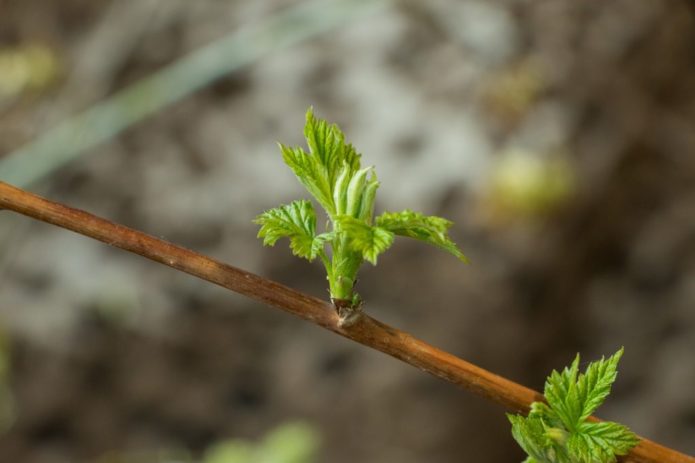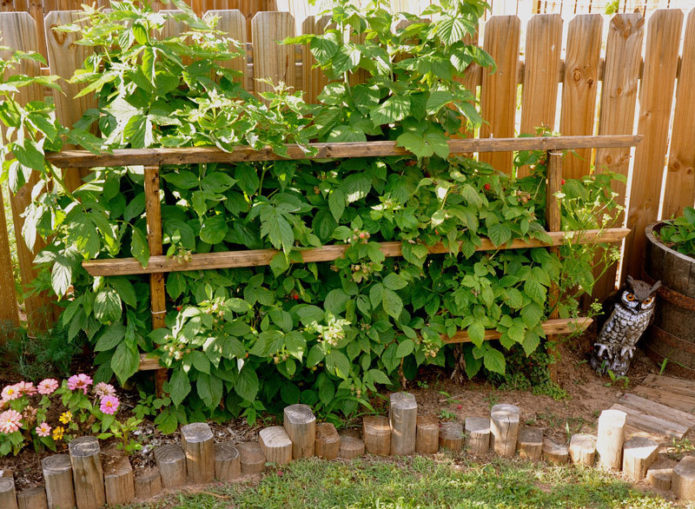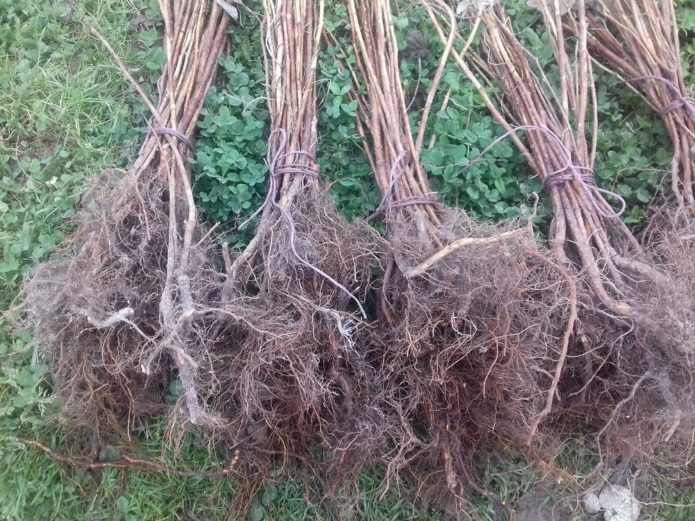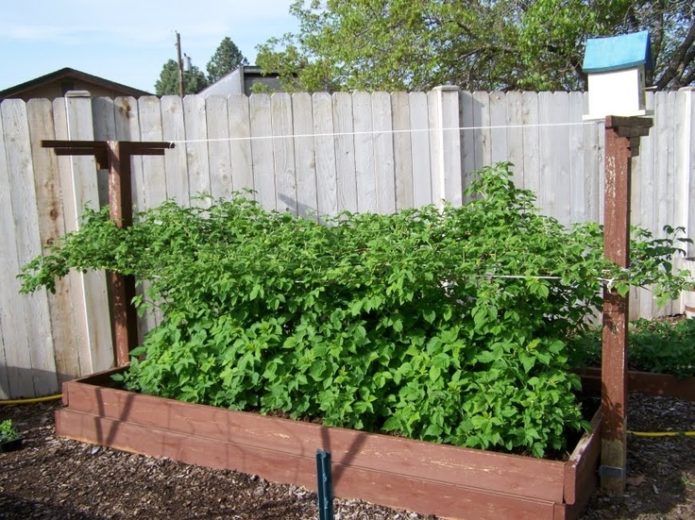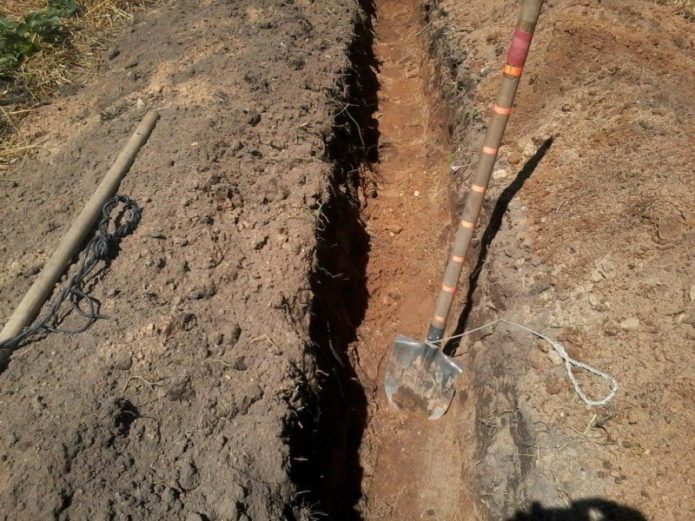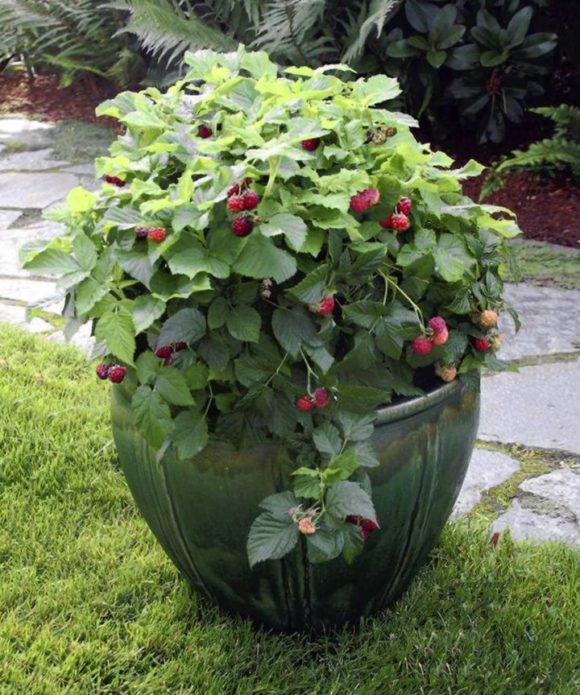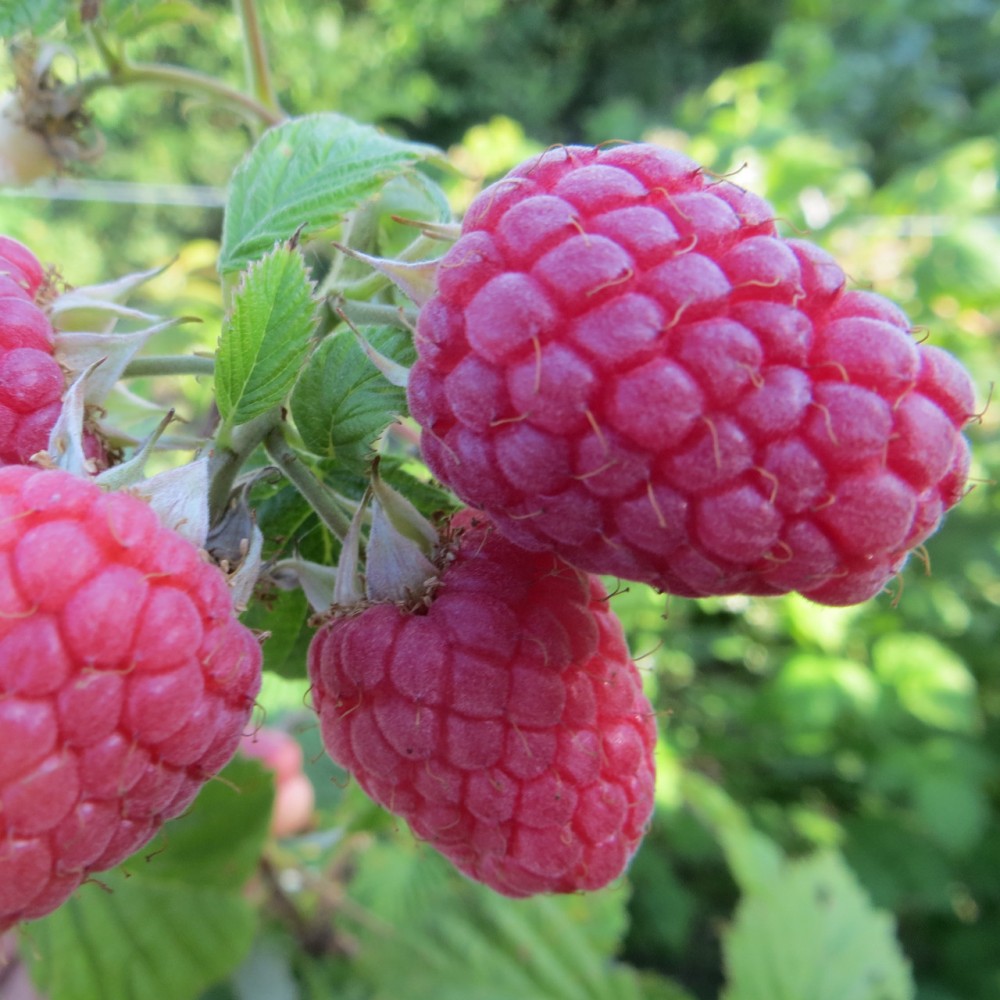Repaired raspberries are becoming interesting to many gardeners: with relatively simple care, you can get a harvest of delicious berries up to frost. Planting it does not differ much from planting ordinary varieties, but the choice of the site and the preparation of the soil must be approached more responsibly. There are many planting methods, and each gardener chooses it based on the climate, terrain and personal preferences.
Content
Stages of planting remontant raspberries
In order for the remontant raspberry to grow for many years and constantly please with abundant harvests, it must be planted on time and correctly. Of great importance are:
- the correct choice of the landing date;
- the location of the raspberry tree in the garden;
- qualified soil preparation for planting;
- selection and preparation of seedlings;
- the correct choice of planting technology (on a flat surface, ridge, high ridge, etc.);
- accurate implementation of the actual planting of seedlings;
- care of seedlings after planting.
It must be understood that raspberries will live and bear fruit in one place for many years, so there is no need to rush in choosing a place, preparing it and actually planting remontant raspberries. Caring for remontant varieties is significantly different from caring for ordinary raspberries, but the planting itself is carried out in about the same way as planting most berry bushes.
Planting dates for remontant raspberries
Repaired raspberries, like ordinary ones, are planted both in spring and autumn: respectively, from the very beginning of spring work in the garden until the end of April and from the very end of summer to mid-October. The optimal planting dates are determined mainly by the climate of the region. Spring planting is typical for those areas where severe frosts are possible in September, and real winter comes early.
In addition, they often try to plant raspberries in spring where the weather is too dry in autumn, and in spring the reserves of soil moisture are significant: for example, the Middle and Lower Volga regions, as well as some regions of the Urals. In other regions, the autumn option is preferable.
Spring planting is carried out when a stable relative warmth occurs, that is, the cessation of significant frosts and a confident transition of average daily temperatures to the region of positive values. It is better if daytime temperatures at this time are in the range of + 10 ... + 15 aboutFROM. Planting should be completed before budding on raspberries. But the preparation of the site, of course, is carried out in advance, in the fall.
Autumn planting must be completed about 20 days before the first serious frost, therefore, planting in the middle lane lasts from early September to October 5-10. In the south, planting raspberries is often possible until mid-November. Late in the autumn planting is fraught with freezing of the root system due to incomplete rooting of plants and their subsequent death.
Thus, both spring and autumn planting have their pros and cons; in both cases, both starting work too early and being late are dangerous. It is physically easier to plant raspberries in the fall, but in arid and frosty regions it is safer to do so in the spring.
Young seedlings with a closed root system, which have been sold in abundance in recent years, can be planted almost at any time, but this is undesirable during the peak of the summer heat. It is better to finish planting even seedlings with a good earthy clod no later than mid-June, and start autumn planting no earlier than mid-August.
Choosing a place for raspberries
Repaired raspberries can bear fruit all summer (from the end of June to the very frost). At the same time, many gardeners prefer to grow it using a different technology, so that it gives one, but a large harvest in late summer and autumn. Most remontant varieties do not require pollinators, so there is no need to worry about planting several varieties at the same time.
As a rule, the shoots of remontant raspberries are much higher than ordinary ones, which leaves an imprint on the choice of location and organization of the plantation: the device of trellises or other supports for tying is in most cases necessary. Long-term fruiting requires more fertile soil, the organization of the possibility of constant watering, as well as better illumination of the site than in the case of summer varieties.
As for the location of groundwater, this is not the most important factor for raspberries: the roots do not penetrate deeper than 40 cm, therefore, the occurrence of water at a meter depth will not interfere with them, only clearly swampy areas are unsuitable.
In addition to the fact that the place for the raspberry tree should be well lit and warmed up by the sun's rays, it is necessary to create conditions for the absence of drafts. Since tree planting is not suitable for this (they create shade), try to plant raspberries along low fences or near rows of bushes such as honeysuckle or gooseberries.
Currants are considered an undesirable neighbor for raspberries due to the presence of common pests.
In particularly hot climates, it is better to slightly sacrifice light and plant raspberries in partial shade: drying out the soil for remontant varieties is more destructive than a reduced amount of light. But if the bushes are in the shade for more than half of the daytime, the yield will drop dramatically, and the berries will become small and sour.
Raspberries are generally picky about their neighbors. Rather, on the contrary, it is worth remembering that the raspberry tree grows rapidly, as a result of which it can fill the vegetable beds. Many gardeners combat this phenomenon by digging deep slate or iron sheets to keep raspberry roots from spreading.
It is advisable to plant various odorous plants nearby that repel pests: garlic, marigolds, oregano, etc.
The ideal reaction of the soil extract is close to neutral. Weakly acidic soils are suitable for raspberries, but if horsetail or plantain have settled on the site, then the soil is too acidic. It is not difficult to deal with acidic soils: when digging, add chalk, slaked lime or dolomite flour (up to a liter jar per 1 m2).
From the point of view of soil composition, light loams or sandy loams are optimal. You can even have sandy soils, but you need to apply increased doses of fertilizers and water them often. If there is time, a year before planting raspberries, it is worth sowing green manure (mustard, oats, lupine, etc.) in the selected area. You can do this even at the beginning of this summer, if the site is free.Before digging up the soil, at the end of summer, grasses that have not yet blossomed are mowed and embedded in the ground: they serve as a good fertilizer, heal the soil and improve its structure.
Preparing the soil for planting remontant raspberries
In addition to correcting acidity, a lot has to be done with the soil before planting raspberries. Especially if it is very clayey or damp: in such cases, up to a bucket of river sand is added to each square meter during digging. With the threat of waterlogging, the amount of drainage is increased: in addition to mixing sand to the soil, a layer of pebbles or broken brick is laid on the bottom of the planting pits or trenches.
In the chernozem regions, it is customary to add hulls from sunflower seeds or buckwheat hulls to the soil: they significantly improve air permeability.
Any fertilizers are suitable for the raspberry, but it is undesirable to use chlorine-containing ones. When digging the soil, the main nutrients are introduced in the form of organic fertilizers, they take a lot: 3-4 buckets of humus per 1 m2... In regions where there are no problems with peat, it is also suitable for raspberry. Wood ash when planting is taken about a liter jar per 1 m2, with a lack of natural fertilizers, increase the amount of mineral fertilizers. But even to humus add a glass of superphosphate and potassium sulfate.
Cultivation of remontant raspberries is impossible without the presence of a large amount of organic matter: annually, before wintering, humus is covered with a layer of up to 10-15 cm around the bushes, and in the spring it is embedded in the soil. As for the actual planting, a deep digging of the site with fertilizers is carried out 2-3 weeks before the autumn planting and at any autumn time if planting is planned for the spring.

If getting good humus is problematic, perhaps you shouldn't mess with planting remontant raspberries
Although the seedling itself is buried during planting and not very much (the root collar is lowered only a few centimeters below ground level), and before planting they dig holes or trenches, the soil must be dug deep beforehand. This is done at least on a shovel bayonet in order to move the fertilizers to a sufficient depth and distribute them over the entire area of the selected area. The fact is that raspberries will grow roots very quickly so that they will fill the entire plantation with practically no passes, and everywhere they need fertile soil.
Selection and preparation of seedlings
There are many ways to propagate raspberries, and ready-made seedlings are not always available. You can even plant raspberries with pieces of roots - root cuttings. But it is safer, especially for an inexperienced gardener, to still purchase seedlings. They must be healthy and strong. This means that the stem at the base should be 5–8 mm in diameter, but most importantly, a well-developed root system is required.
In addition to the main roots, raspberries should have a powerful system of fibrous roots: thin, strong, which are easily bent, but do not break. They don't have to be long, 18–20 cm is enough, but there should be a lot of small suction roots. A small amount of dried roots is not fatal, but it is better to cut them off with a sharp pruner.
Before planting, the seedlings are completely immersed in water for 1-2 days. If there is no large capacity, at least the roots are soaked. Immediately before planting in the soil, it is advisable to dip the roots in a clay mash. It is prepared from equal proportions of mullein and clay and enough water to obtain a creamy consistency.
Planting methods of remontant raspberries
The technology of further actions depends on many factors, but mainly on the parameters of the site and the wishes of the owner. There are many ways of planting remontant raspberries, the most famous of them are as follows:
- landing in separate pits;
- planting in furrows;
- trench (tape) landing;
- landing in a container;
- bush method.
All these methods differ in the relative position of the seedlings in relation to each other, and all of them can be implemented both on a horizontal surface, located at the same level with the ground of the entire garden, and on elevations: ridges or ridges. As a rule, elevation is required in cases where groundwater is close or the climate of the area is characterized by excessive rainfall (although raspberries require a lot of moisture, but the roots should not stand in the water), or in cold regions where high beds are made warm.
Planting raspberries on the ridges
Ridge planting is a time-consuming method that must be resorted to in the case of heavy soils or marshy areas. For such a landing, do the following.
- They dig a deep, but not wide trench (depth about 80 cm, width - as it turns out, length - as needed). Various organic debris is poured into the bottom in a layer of 30–40 cm, the basis of which is wood waste: sawdust, shavings, bark, trimmings of small branches.
- The earth taken out of the trench is mixed with humus (3 buckets per 1 m2), add 150-200 g of superphosphate and return it to the trench on top of the garbage, leaving part of the mixture for backfilling the roots of the seedlings. At the same time, the trench is almost completely covered up, making it level with the ground. Water well to saturate all its contents with water.
- Saplings are planted in one row at distances of at least 50 cm from each other, placing the seedlings on top of the fertile mixture. Sprinkle the roots with a prepared mixture of soil with fertilizers so that the root collar is covered by no more than 1–2 cm. Use a shovel to form a comb.
- Along the edges of the formed ridge, so that it does not collapse, pieces of slate or wide boards are dug in, making a fence about 30 cm high.
- Water the plantings, spending at least 5 liters of water per seedling, and mulch well with sawdust, peat or straw.
Planting raspberries in warm beds
The method is similar to the previous one, but even more time consuming. Essential in cold climates and very early harvests if desired. The garden bed is considered "warm" because the soil is warmed by rotting organic matter introduced in large quantities to the very bottom of the bed, directly under the roots of the shrub. The length of the bed can be any, the width is traditionally kept about 80 cm. Prepare the bed long before planting.
- Dig trenches with a width equal to the width of the future bed and a depth of about a meter. Fences are made of slate, taking into account that the bed will rise above the ground by at least 60-80 cm. Pour several buckets of sawdust on the bottom for each meter of the trench, spill them with a weak solution of potassium permanganate.
- Sawdust (layer 10–15 cm) is covered with the same height layer of excavated soil, premixed with humus or compost in a 1: 1 ratio.
- Further, in the same layer, various organic garbage, fallen leaves of trees, small twigs are piled, sprinkled with mineral fertilizers (100 g / m potassium sulfate and superphosphate each) and pouring mullein infusion. Sprinkle with a small layer of soil.
- The layers of organic matter and earth are alternated in the required amount up to the selected height, but the top layer is peat, mixed with peelings and humus. Water the garden well, spending at least 5 buckets of water per meter. When the rotting of organic matter develops properly, it will be very warm inside the garden.
- Planting begins no earlier than 2-3 weeks after the arrangement of the beds. The technology of planting raspberries is usual: they make holes of the required size, slightly deepen the seedlings, cover them with soil mixture, water and mulch.
As it matures, the bed will gradually settle, so periodically it is necessary to sprinkle earth on it, or better, its mixture with humus or peat.
Landing in separate pits
The method, which does not involve digging large trenches, is used in the case of light fertile soils, as well as when the seedlings are planted at considerable distances from each other. As a rule, they are kept at least 1.5 m between the rows of raspberries and 70–90 cm between the seedlings in a row.
Dig holes measuring 40 cm in all dimensions. A small amount of local fertilizer is introduced into the pit (no more than half a bucket of compost and a handful of wood ash). Raspberries are planted with minimal deepening, well watered and mulched. In the future, the plants are formed in rows, distributing the emerging shoots towards the neighboring ones.
Ordinary method, or planting in furrows
In fact, the method is a modification of the previous one and is applied in the same cases. It's just that some gardeners find it easier to dig a common furrow about 40 cm wide and deep than individual holes. A little compost and ash are poured into the bottom of the furrow and raspberries are planted in the same way as in the pit planting, placing the seedlings at the same distances, in one row.
Ribbon landing
Belt planting, or planting in a wide trench, is not often used on personal plots, since it is laborious (just as in the case of making warm beds, you need to dig a wide deep trench). Traditionally, this technique is used in the industrial cultivation of berries. It is especially effective on sandy soils. The method is good in that a large amount of fertilizer is placed in the trench, which means that once prepared, the trench serves for many years.
Trenches about half a meter deep are dug a month before planting, directing them from north to south. The length is as required, and the width can be different. More often, with this method, raspberries are planted with a ribbon in two rows, which means that the width must be maintained about a meter. At the very bottom they put clean rotted manure or good humus with a layer of about 15 cm, sprinkling it with wood ash, superphosphate and potassium sulfate. Then a layer of removed soil is poured, mixed with humus, and on the very top - clean soil.
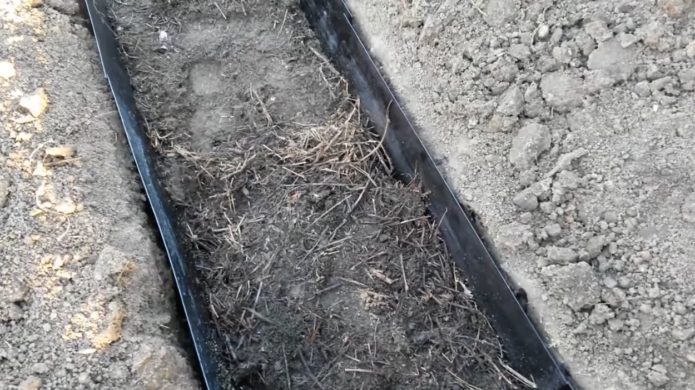
A large number of various fertilizers are placed in the trench in layers, which will last for a long time
Raspberries are planted almost without deepening, digging holes of the required size and spreading the roots well, after which they are watered and mulched. The distance between seedlings in a row is about 70 cm, between rows in a tape - 50-60 cm. If it is necessary to arrange several belts, about one and a half meters are left between the trenches.
Planting in a container
It has become fashionable to use unnecessary barrels, buckets, bags and other containers for planting various plants in summer cottages. After all, these containers can be put anywhere, even on asphalt, which means they can save space. Raspberries are sometimes planted in the same way if only a few bushes are required. In the container, remove or strongly perforate the bottom, bury it shallowly into the ground and fill it with fertile soil, after which the seedlings are planted, one at a time in a bucket or barrel.
Bush method
Unlike a ribbon, or ordinary, planting, when a fruiting raspberry looks like one side or a wall in which the stems are located only in 1-2 rows, when bush cultivation raspberries look like separate bushes, including 10-12 closely spaced to each other shoots. This means that long distances are left between the seedlings when planting: the usual scheme is (1.0-1.2) x (1.5-2.0) m. Bushes can also be staggered.
In the selected places, planting pits are prepared with sizes from 50 cm in depth, length and width, they are well filled with fertilizers and one seedling is planted in each in the usual way. After 2–3 years, the bushes become adults, consist of many shoots and bear fruit well.
Arrangement of trellis
The vast majority of remontant varieties of raspberries require a garter, since their shoots are long, not very thick, and when the crop is loaded, they fall on the ground. With bush growing, you can drive a strong high stake into the center of the planting pit already when planting, and then tie the shoots to it. In most cases, it is more convenient to equip a common trellis along a row of landings.
For the trellis, strong posts or metal pipes are driven into the ground. The distance between them is 3-4 m. The height of the column above the ground is at least one and a half meters. A strong wire with a diameter of 4–5 mm is pulled between the posts. The number of rows of wire depends on the type of raspberry, but not less than three. The lower wire is located at a height of 30–40 cm from the ground, the next one is 1 m, and the upper one is 1.5 m. If the variety is high-yielding, it is advisable to pull the wire more often.

When growing trellis, it is more convenient not to create bushes, but to arrange the shoots in a row
Each shoot, as it grows, is tied to each wire, trying to position them so that there is at least 10 cm between the stems. The garter is carried out with any convenient twine using the "figure eight" method.
Nuances of spring and autumn planting
There are two very different ways of growing remontant raspberries:
- with the traditional method, the harvest is obtained throughout the summer: first on last year's shoots, and by autumn - on annuals;
- with the method, which is used more and more often, in the fall, all the shoots are mowed, leaving the plants to winter with only small stumps. All the forces of the raspberry tree are allowed to get one, plentiful, harvest on annual shoots.
However, regardless of the intended cultivation method, spring and autumn planting are slightly different. More precisely, the pruning of planted bushes is different. So, when planting in spring with seedlings, they act in almost the same way as in the case of ordinary varieties of raspberries. Last year's shoots with 2-3 buds are left above the surface of the earth, that is, up to 20 cm high. As the roots grow and the seedling takes root, leaves will appear from these buds, and then annual shoots will appear from the ground, and closer to autumn (and for many varieties in July) you can taste the berries.
Video: planting remontant raspberries in spring
Otherwise, the spring planting does not differ much from the autumn planting. Unless you can put more nitrogen fertilizers (in particular, humus) in the spring than in the fall, and watch the soil moisture more closely: snow moisture tends to quickly end. In the fall, less watering is usually required.
In autumn, immediately after planting, the entire aerial part is cut off with a sharp secateurs, leaving hemp 1–2 cm high. This is necessary to prevent the possible awakening of buds during autumn warming and, as a result, the death of shoots as a result of subsequent frosts. When planting in autumn, mulching the soil with a thicker layer is carried out, and closer to winter, measures are taken to retain snow on the raspberry tree: poorly established young bushes especially need warmth, and snow is the most reliable insulation.
Landing features in different regions
The principles of planting remontant raspberries differ little depending on the region, but the timing, as well as the height of the beds, differ: in cold climates, the construction of high warm beds is preferable. In the middle lane, and even more so in the south, this is not necessary, unless the groundwater is close.
The fruiting times of the same variety of remontant raspberries in the south and north of our country can differ by 3-4 weeks, which should be taken into account when choosing the planting time. But in any case, in the north and in Siberia, this should be done in the spring, and in other regions - at the request of the gardener.
Those who want to plant remontant raspberries in the middle lane in the spring can start preparing the planting holes in the very early spring, if they could not do it in the fall.Here, and in particular in the Moscow region, the actual planting can be carried out approximately from March 25 to April 20, although, of course, there is no need for a year.
The Moscow region is distinguished by a large number of wetlands, as well as unpredictable weather in the winter, when frosts alternate with thaws. Therefore, despite the relatively mild average annual climate, spring planting is preferred here so as not to risk it. Drainage must be placed in the planting pits. Autumn planting, in trouble-free areas, is possible throughout September. All of the above applies to most of Belarus.
In Siberia and the Urals, the main problem is to choose the warmest, windproof area. At the same time, you have to sacrifice lighting, planting raspberries in the shade of houses, near strong reliable walls. Earlier on May 1-10, they try not to plant raspberries: there is a high risk of sudden cold snaps. If there is a need for autumn planting, they try to finish it before September 10.
Video: planting raspberries in Siberia
In the southern regions of the Russian Federation, as in most of Ukraine, both spring and autumn planting are equally popular. In the spring, planting work is possible in March, they end with the beginning of bud break, which can happen as early as April. There is no need to rush in autumn, the most suitable month is October. In most southern regions, you do not have to worry about freezing raspberries, but you need to carefully monitor the soil moisture after planting so as not to dry out the roots of the seedlings that have not yet taken root.
Planting remontant raspberries is difficult, rather physically: due to the high yield and power of the bushes, it requires a lot of nutrition, so you have to dig large holes or trenches. Otherwise, there are no problems with planting seedlings, but one must not be mistaken with the timing, make the right choice between spring and autumn.
